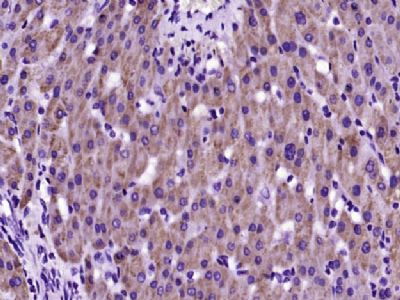SARM1 Polyclonal Antibody
Purified Rabbit Polyclonal Antibody (Pab)
- SPECIFICATION
- CITATIONS
- PROTOCOLS
- BACKGROUND

Application
| IHC-P, IHC-F, IF, E |
|---|---|
| Primary Accession | Q6SZW1 |
| Reactivity | Rat, Pig, Dog, Bovine |
| Host | Rabbit |
| Clonality | Polyclonal |
| Calculated MW | 80 KDa |
| Physical State | Liquid |
| Immunogen | KLH conjugated synthetic peptide derived from human SARM1 |
| Epitope Specificity | 321-420/724 |
| Isotype | IgG |
| Purity | affinity purified by Protein A |
| Buffer | 0.01M TBS (pH7.4) with 1% BSA, 0.02% Proclin300 and 50% Glycerol. |
| SUBCELLULAR LOCATION | Cytoplasm. |
| SIMILARITY | Contains 2 SAM (sterile alpha motif) domains.Contains 1 TIR domain. |
| SUBUNIT | Interacts with TICAM1/TRIF and thereby interferes with TICAM1/TRIF function. |
| Important Note | This product as supplied is intended for research use only, not for use in human, therapeutic or diagnostic applications. |
| Background Descriptions | SARM, also known as SAMD2, SARM1 or KIAA0524, is a 724 amino acid protein that localizes to the cytoplasm and contains one TIR domain and two sterile alpha motif (SAM) domains. Expressed predominately in liver and kidney and present at lower levels in placenta, SARM interacts with TICAM-1 and, via this interaction, blocks the transcriptional activation activity of TICAM-1 and functions as a negative regulator of Toll-like receptor signaling. Additionally, SARM is thought to be involved in innate immune responses and may also play a role in the negative regulation of NFⅹB activation. SARM exists as two alternatively spliced isoforms that are encoded by a gene which maps to human chromosome 17. |
| Gene ID | 23098 |
|---|---|
| Other Names | NAD(+) hydrolase SARM1, NADase SARM1, hSARM1, 3.2.2.6, NADP(+) hydrolase SARM1, 3.2.2.-, Sterile alpha and Armadillo repeat protein, Sterile alpha and TIR motif-containing protein 1 {ECO:0000303|PubMed:18089857, ECO:0000303|Ref.2}, Sterile alpha motif domain-containing protein 2, MyD88-5, SAM domain-containing protein 2 {ECO:0000312|HGNC:HGNC:17074}, Tir-1 homolog, HsTIR, SARM1 |
| Target/Specificity | Predominantly expressed in kidney and liver. Expressed at lower level in placenta. |
| Dilution | IHC-P=1:100-500,IHC-F=1:100-500,IF=1:50-200,ELISA=1:5000-10000 |
| Storage | Store at -20 ℃ for one year. Avoid repeated freeze/thaw cycles. When reconstituted in sterile pH 7.4 0.01M PBS or diluent of antibody the antibody is stable for at least two weeks at 2-4 ℃. |
| Name | SARM1 |
|---|---|
| Function | NAD(+) hydrolase, which plays a key role in axonal degeneration following injury by regulating NAD(+) metabolism (PubMed:25908823, PubMed:27671644, PubMed:28334607). Acts as a negative regulator of MYD88- and TRIF-dependent toll-like receptor signaling pathway by promoting Wallerian degeneration, an injury-induced form of programmed subcellular death which involves degeneration of an axon distal to the injury site (PubMed:15123841, PubMed:16964262, PubMed:20306472, PubMed:25908823). Wallerian degeneration is triggered by NAD(+) depletion: in response to injury, SARM1 is activated and catalyzes cleavage of NAD(+) into ADP-D-ribose (ADPR), cyclic ADPR (cADPR) and nicotinamide; NAD(+) cleavage promoting cytoskeletal degradation and axon destruction (PubMed:25908823, PubMed:28334607, PubMed:30333228, PubMed:31128467, PubMed:31439792, PubMed:31439793, PubMed:32049506, PubMed:32828421, PubMed:33053563). Also able to hydrolyze NADP(+), but not other NAD(+)-related molecules (PubMed:29395922). Can activate neuronal cell death in response to stress (PubMed:20306472). Regulates dendritic arborization through the MAPK4-JNK pathway (By similarity). Involved in innate immune response: inhibits both TICAM1/TRIF- and MYD88-dependent activation of JUN/AP-1, TRIF-dependent activation of NF-kappa-B and IRF3, and the phosphorylation of MAPK14/p38 (PubMed:16964262). |
| Cellular Location | Cytoplasm. Cell projection, axon {ECO:0000250|UniProtKB:Q6PDS3}. Cell projection, dendrite {ECO:0000250|UniProtKB:Q6PDS3}. Synapse {ECO:0000250|UniProtKB:Q6PDS3}. Mitochondrion Note=Associated with microtubules. {ECO:0000250|UniProtKB:Q6PDS3} |
| Tissue Location | Predominantly expressed in brain, kidney and liver. Expressed at lower level in placenta. |

Thousands of laboratories across the world have published research that depended on the performance of antibodies from Abcepta to advance their research. Check out links to articles that cite our products in major peer-reviewed journals, organized by research category.
info@abcepta.com, and receive a free "I Love Antibodies" mug.
Provided below are standard protocols that you may find useful for product applications.
If you have used an Abcepta product and would like to share how it has performed, please click on the "Submit Review" button and provide the requested information. Our staff will examine and post your review and contact you if needed.
If you have any additional inquiries please email technical services at tech@abcepta.com.













 Foundational characteristics of cancer include proliferation, angiogenesis, migration, evasion of apoptosis, and cellular immortality. Find key markers for these cellular processes and antibodies to detect them.
Foundational characteristics of cancer include proliferation, angiogenesis, migration, evasion of apoptosis, and cellular immortality. Find key markers for these cellular processes and antibodies to detect them. The SUMOplot™ Analysis Program predicts and scores sumoylation sites in your protein. SUMOylation is a post-translational modification involved in various cellular processes, such as nuclear-cytosolic transport, transcriptional regulation, apoptosis, protein stability, response to stress, and progression through the cell cycle.
The SUMOplot™ Analysis Program predicts and scores sumoylation sites in your protein. SUMOylation is a post-translational modification involved in various cellular processes, such as nuclear-cytosolic transport, transcriptional regulation, apoptosis, protein stability, response to stress, and progression through the cell cycle. The Autophagy Receptor Motif Plotter predicts and scores autophagy receptor binding sites in your protein. Identifying proteins connected to this pathway is critical to understanding the role of autophagy in physiological as well as pathological processes such as development, differentiation, neurodegenerative diseases, stress, infection, and cancer.
The Autophagy Receptor Motif Plotter predicts and scores autophagy receptor binding sites in your protein. Identifying proteins connected to this pathway is critical to understanding the role of autophagy in physiological as well as pathological processes such as development, differentiation, neurodegenerative diseases, stress, infection, and cancer.


